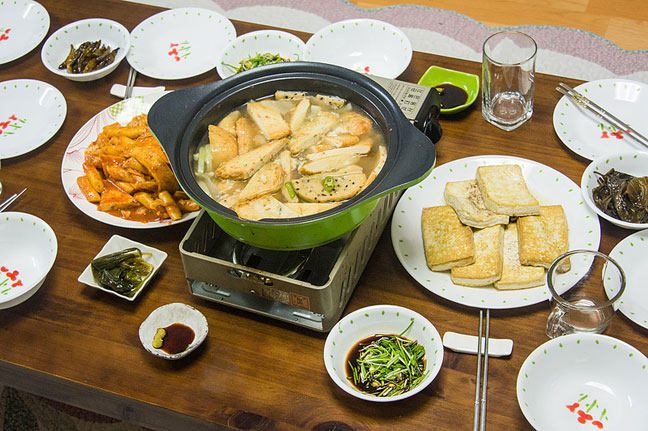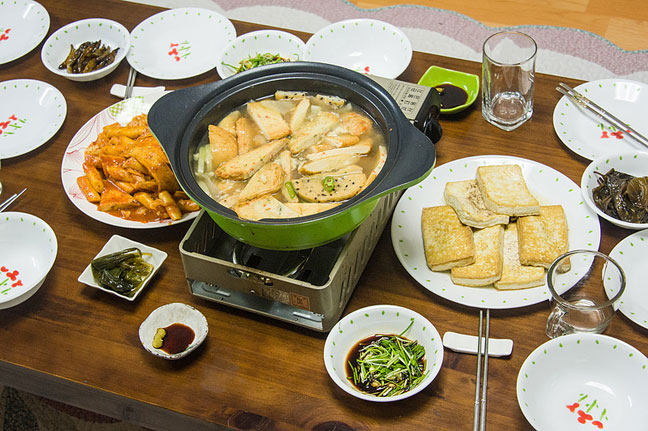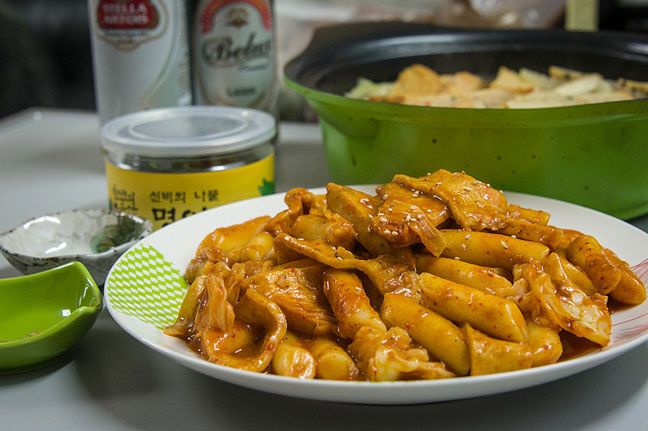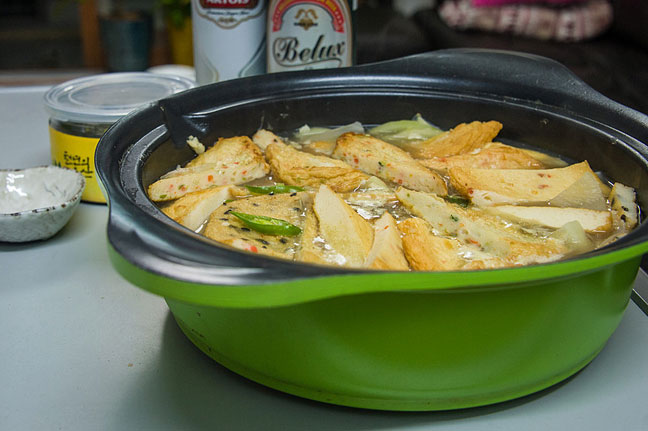Finding Local Food, in a Korean Home

All photos by Coen Wubbels
One thing was certain: Had we searched for dinner on our own upon arriving in Seoul, we never would have eaten fish cakes, rice cakes in gochujang, fried tofu, and anchovies with peanuts for our first meal. We don’t speak Korean, and we hadn’t yet done much research about what to eat here. Where would we have found these dishes? How would we even have known they exist?
My partner, Coen, and I were in luck. A Korean couple had followed our travel adventures on our website for a while, and when they learned we were coming to their country, Jin and Suna offered us accommodation in their home. Local people inviting you to their homes is always a gift, but starting your journey this way feels like a special, beautifully wrapped present.
It makes you feel welcome and helps you to immerse yourself right away in a new place and culture on a deeper level: learning the first words in a new language, getting a feel for cultural norms that go beyond the “dos and don'ts” in a guidebook. In our case it was also a way to get an immediate taste of some of Korea’s traditional and famous foods, and a crash course in local dining customs: Our hosts turned out to be great cooks.
Rice cakes, or tteok
Jin and Suna live in one of the many apartment complexes that characterize Korean cities. Far from being architectural highlights, they offer comfort and often include floor heating. The latter was particularly welcome, as it was wintertime and we’d be sitting a lot on the floor in this country. The small, two-bedroom apartment had a kitchen-cum-living room with a couch and a long, low side table. The latter doubled as a dining table when we sat ourselves on the floor around it.
Once Suna returned home from work—after 8pm, as usual—she quickly set about preparing a meal in the kitchen. From a container in the fridge she took some rectangular pieces of tofu and briefly fried them in canola oil. Our memories of eating tofu back home in the Netherlands involved a tough, chewing-gum kind of texture and no flavor. This tofu, by contrast, was so soft it nearly melted in our mouths, like cottage cheese or Indian paneer. Jin couldn’t relate to “our’’ tofu at all. “Tofu chewy? No, tofu should always be soft,” he commented.
In the meantime, Jin opened a box that had arrived in the mail. “Ah, the fish cakes I ordered from Busan.” Busan? We knew this was a coastal town more than 180 miles south of Seoul, so we asked how he managed to get fresh food from so far away. “Online, of course!” he answered, as if it were the most normal thing in the world.
Fish cakes, or eomuk
“Busan has the best fish cakes in Korea,” he continued. (One detail we picked up that evening was that Koreans speak about Korea, not South Korea, as we’d thought.) “So I go online, order them, and they’re here one day later, packed in ice in a Styrofoam box.” The Korean word for fish cakes is eomuk, and they look nothing like what we Westerners consider “cake”: Fish cakes are slabs of pureed fish and seafood, in this case flavored with soy sauce and chili pepper.
And so went our introduction to the world of Korean food: in a Korean home with delicious food. Our hosts knew we are vegetarians, so they served vegetables and fish, a gesture we very much appreciated. With chopsticks we selected greens from a wasabi-spiked soy sauce, and grazed on myulchi bokkeum, tiny fried anchovies mixed with peanuts. Another popular dish we tried that night was tteok, chewy steamed rice cakes (made from glutinous rice flour) mixed with slices of fish cake in a spicy sauce.
Greens in soy sauce
In Korea, food is about sharing. Dishes are placed on the table in bowls, always in large quantities, Suna explained. “We prepare a lot of food. Not everything is eaten, but we’ll keep it for the next day, so we always have a range of dishes to sample at each meal.” You get a small plate to fill with little amounts of food chosen from the various bowls, using your chopsticks. Instead of gorging yourself with heaping spoonfuls of food, filling your stomach quickly, this way of eating feels like a celebration, a way to truly savor the food and appreciate the effort put into preparing it.
We passed the evening with big smiles on our faces, soaking it all in. When we’d had our fill, I took out my notebook and pen for the next challenge: writing down the names of the dishes, including their spelling in Korean characters, so we’d be sure what to order in restaurants as we explored this beautiful country.
About the author: Freelance writer Karin-Marijke Vis, along with her partner Coen Wubbels (photographer), combine their love for adventure with work. They have traveled in Asia and South America in a Land Cruiser since 2003, and their work has been published in car and travel magazines around the world.
WANT TO SAVE THIS ARTICLE FOR LATER? PIN IT HERE.






